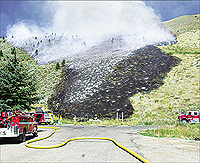Settlement reached over 2001 Sage Fire on town?s edge
Forest Service receives $225,000 to cover $310,000 in expenses
By GREG STAHL
Express Staff Writer
 The 2001 Sage Fire that ignited in a backyard first spread to adjoining sagebrush fields and then up the foothills bordering the densely populated Warm Springs neighborhoods of Ketchum. Photo by Willy Cook
The 2001 Sage Fire that ignited in a backyard first spread to adjoining sagebrush fields and then up the foothills bordering the densely populated Warm Springs neighborhoods of Ketchum. Photo by Willy Cook
|
|
An Iowa-based insurance company has settled with the U.S. Forest Service for the cost of fighting a 300-acre wildfire that burned south-facing ridges in Warm Springs canyon in July 2001.
The Employers Mutual Casualty Co., representing The Wirth Company Inc., a Ketchum-based landscaping business, agreed to pay $225,000 to the Forest Service to cover costs of fighting the fire, which took more than 100 firefighters and a fleet of helicopters and planes to suppress.
But the fire cost the federal agency $310,600, which included bills submitted by local fire departments for their help on the fire.
?It?s a negotiated settlement,? said Sawtooth National Forest spokesman Ed Waldapfel. ?I can?t tell you what their rationale was for the final settlement.?
What?s more, the settlement does not constitute an admission of liability on the part of the insurance company or The Wirth Company, said Ketchum District Ranger Kurt Nelson.
Nonetheless, investigators said it is fairly clear that the Sage Fire started when a lawnmower owned by The Wirth Company became high centered, causing sagebrush and grass to catch fire and quickly spread to national forest land.
The fire first spread to adjoining sagebrush fields and then up the foothills bordering the densely populated Warm Springs neighborhoods of Ketchum.
More than 100 firefighters from the Forest Service, Bureau of Land Management and city and rural fire departments from Ketchum and Sun Valley were involved in bringing the fire under control.
No homes or other buildings were lost or damaged.
According to federal regulations, people who have been determined responsible for starting fires on public land, or for fires burning onto public lands, will be held accountable for suppression and resource rehabilitation costs, Waldapfel said.
?There are a number (of times) when it?s a clear-cut case, when we do collect from an insurance company or those responsible themselves,? Waldapfel said, adding that he does not know what the agency?s success rate is in securing money from responsible parties.
?It?s difficult to actually have that evidence that proves, without a doubt who the responsible party was,? he said. ?In this case, it was pretty clear cut. A $225,000 settlement is better than no settlement at all.?
From 1994 to 2003, federal agencies spent $8.24 billion to fight wildfires throughout the United States.
The majority of the fires in that time span were lightning caused, but people also triggered many. However, it is near impossible to determine how much of that federal agencies were able to reclaim, said Randy Eardley, a spokesman for the Boise-based National Ineragency Fire Center.
?It varies significantly across agencies, across districts, across forests,? Eardley said. ?It varies depending on how tenacious the investigation or that particular management in an area pursues it.?
Some areas are very successful, Eardley said. Others don?t have the investigators or staff to pursue the money. Also, the agencies aren?t always very good at letting people know when they collect.
?A lot of the dollars that are recovered in Idaho?they?re not announced. You?ll never hear about it,? Eardley said. ?The bottom line is, it really depends on how it?s handled on a local level.?
By the numbers, the 2001 season was close to typical. The number of fires and the acres burned were close to the 10-year average. Across the country, however, some areas had more active seasons than others.
What set the season apart from most others is its late start in the West and how quickly it picked up momentum. The National Interagency Fire Center went from a preparedness level 2 (second lowest) to a preparedness level 5 (highest) in eight days.
All told, nearly 3.6 million acres of land burned compared to the 10-year average of about 4 million. There were 84,079 fires compared to the 10-year average of 106,400 fires. A total of 731 structures were burned, and the costs of suppression were $542 million.


 The 2001 Sage Fire that ignited in a backyard first spread to adjoining sagebrush fields and then up the foothills bordering the densely populated Warm Springs neighborhoods of Ketchum. Photo by Willy Cook
The 2001 Sage Fire that ignited in a backyard first spread to adjoining sagebrush fields and then up the foothills bordering the densely populated Warm Springs neighborhoods of Ketchum. Photo by Willy Cook



































